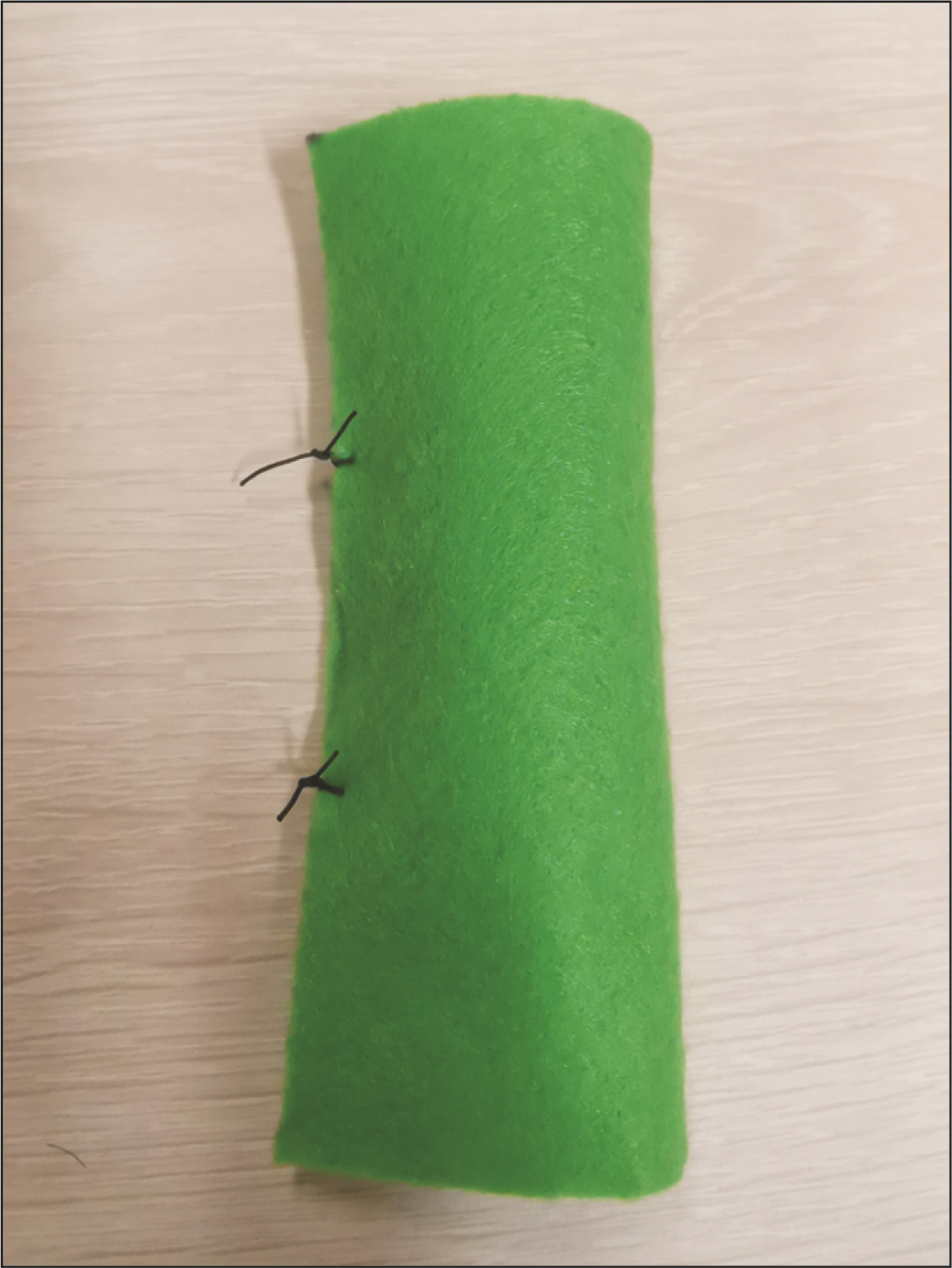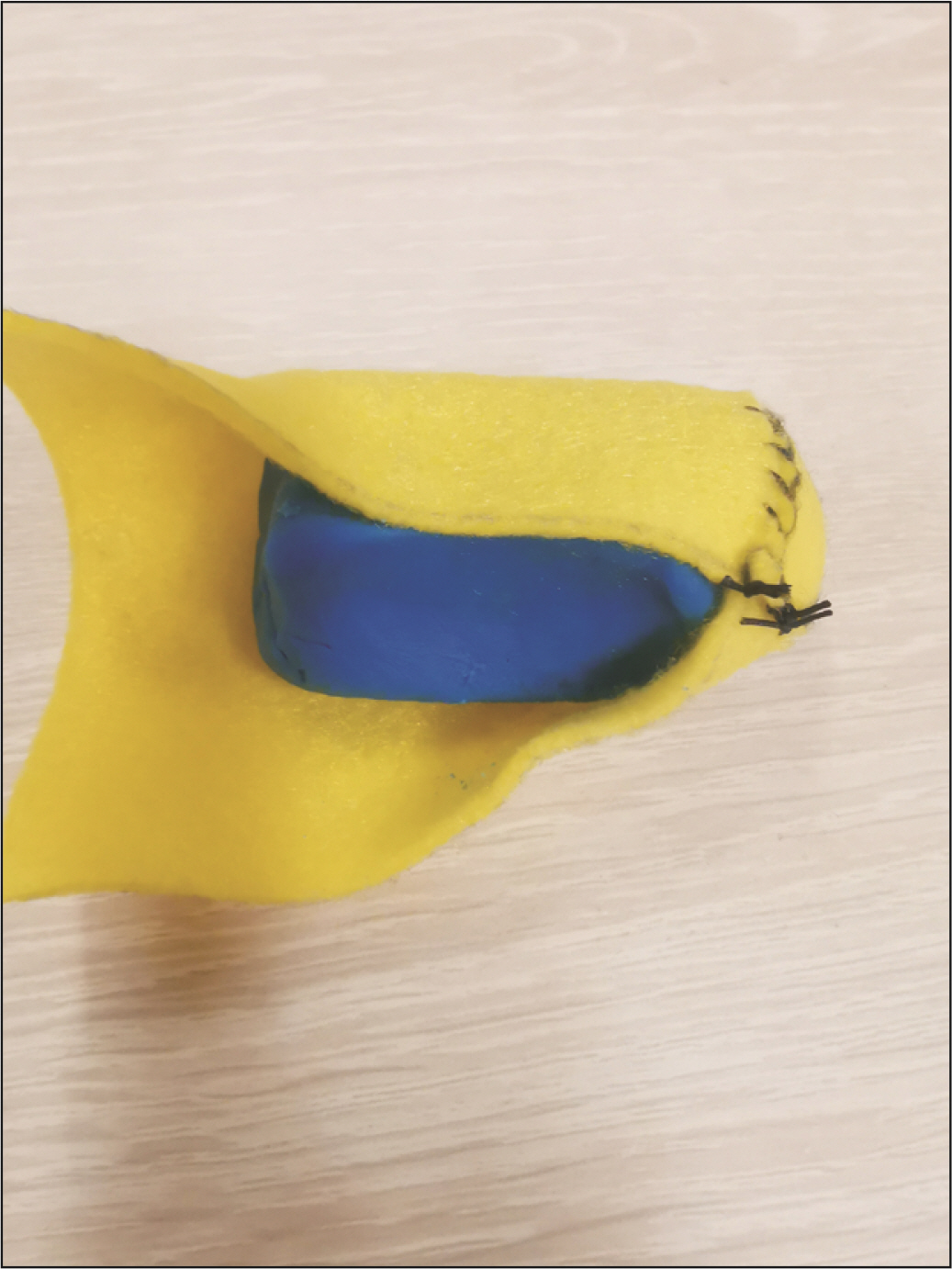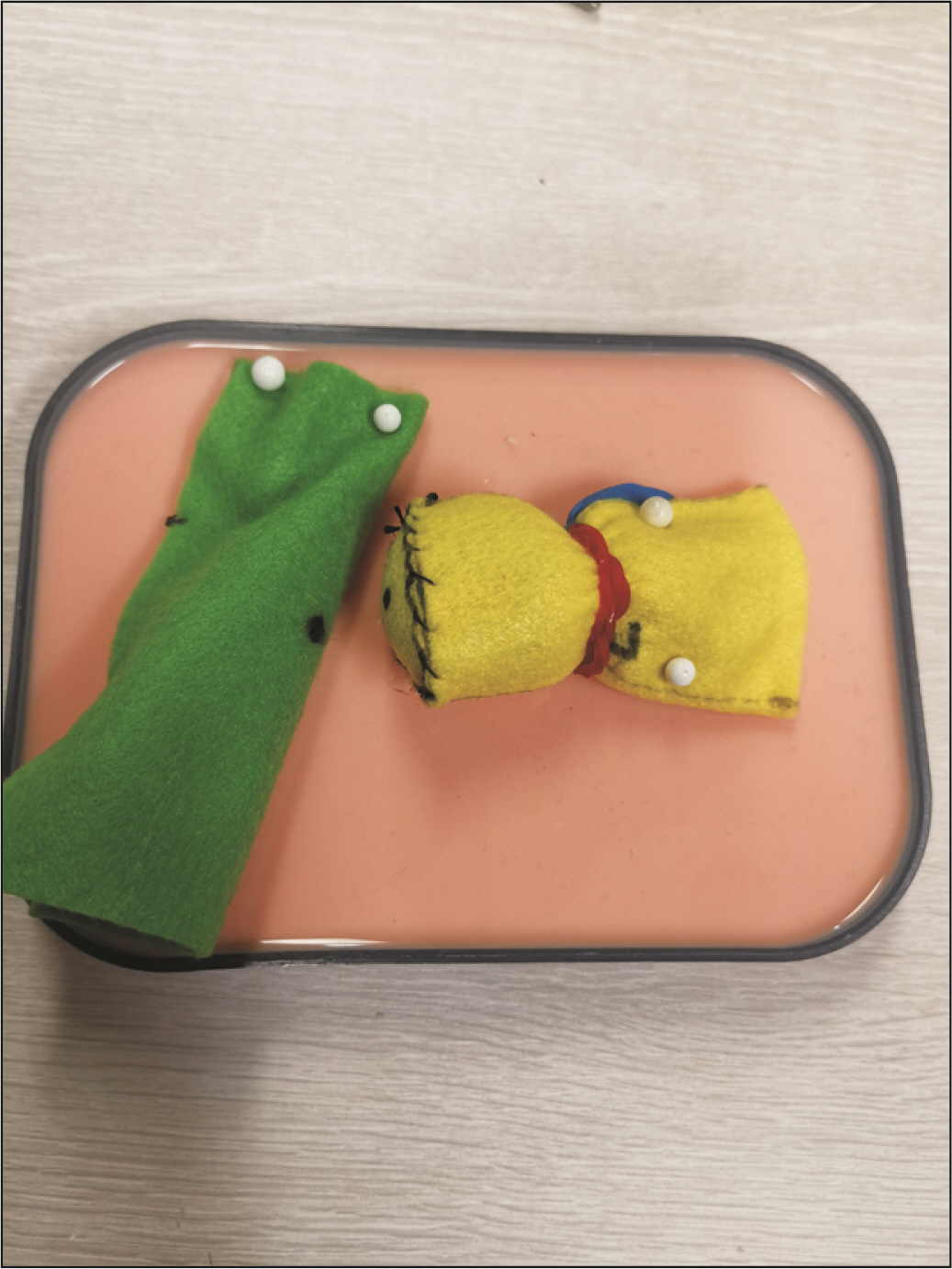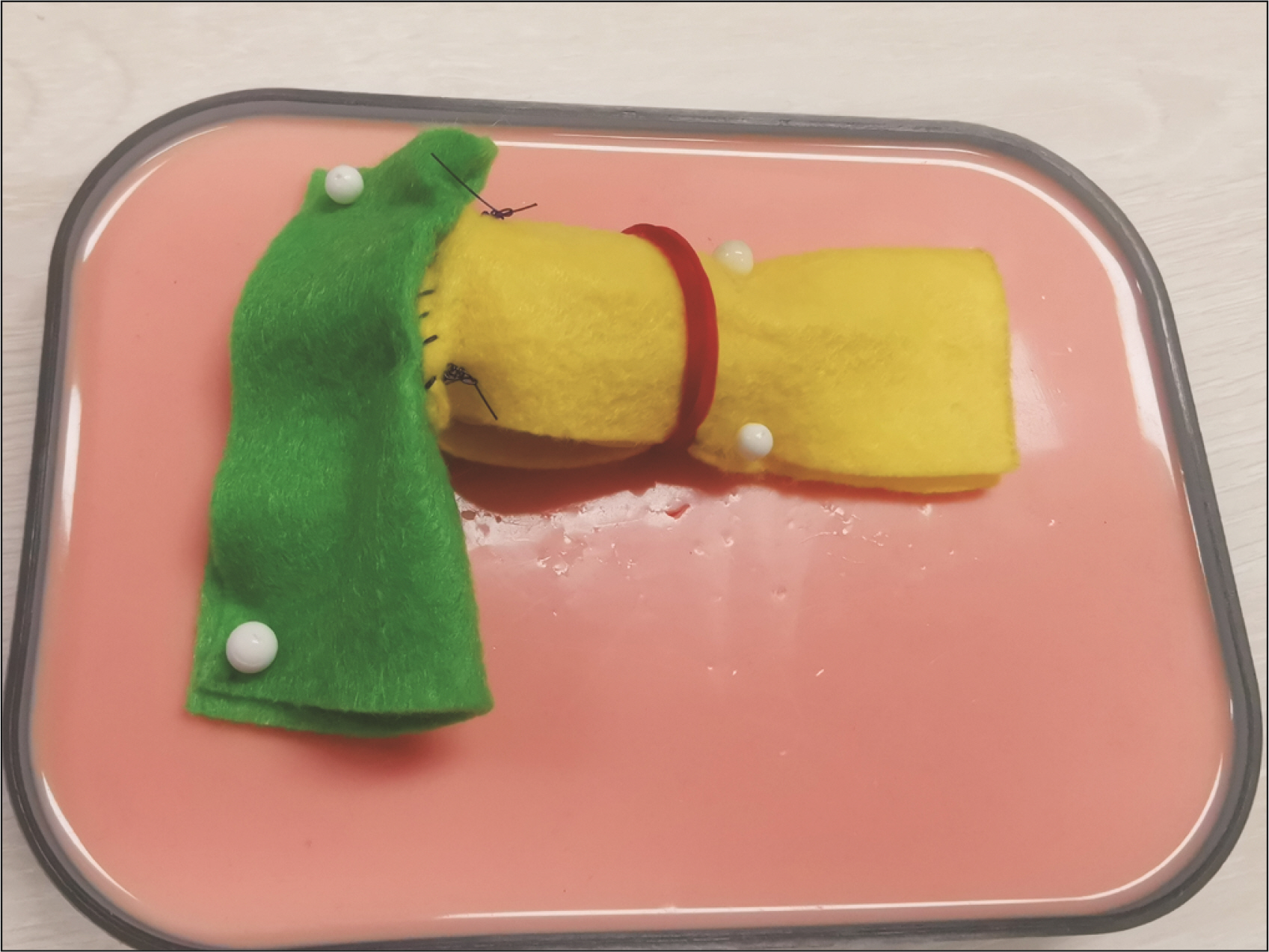Ann Hepatobiliary Pancreat Surg.
2023 Nov;27(4):428-432. 10.14701/ahbps.23-040.
Low-cost model for pancreatojejunostomy simulation in minimally invasive pancreatoduodenectomy
- Affiliations
-
- 1Hepatopancreatobiliary Service, Department of Surgery, Changi General Hospital, Singapore
- 2Surgery Academic Clinical Programme, Duke-NUS Medical School, Singapore
- 3LS Lee Surgery, Mount Elizabeth Novena Hospital, Singapore
- KMID: 2548510
- DOI: http://doi.org/10.14701/ahbps.23-040
Abstract
- Minimally invasive pancreatoduodenectomy (MIS PD) is a well reported technique with several advantages over conventional open pancreatoduodenectomy. In comparison to distal pancreatectomy, the adoption of MIS PD has been slow due to the technical challenges involved, particularly in the reconstruction phase of the pancreatojejunostomy (PJ) anastomosis. Hence, we introduce a lowcost model for PJ anastomosis simulation in MIS PD. We fashioned a model of a cut pancreas and limb of jejunum using economical and easily accessible materials comprising felt fabric and the modelling compound, Play-Doh. Surgeons can practice MIS PJ suturing using this model to help mount their individual learning curve for PJ creation. Our video demonstrates that this model can be utilized in simulation practice mimicking steps during live surgery. Our model is a cost-effective and easily replicable tool for surgeons looking to simulate MIS PJ creation in preparation for MIS PD.
Figure
Reference
-
1. Winer J, Can MF, Bartlett DL, Zeh HJ, Zureikat AH. 2012; The current state of robotic-assisted pancreatic surgery. Nat Rev Gastroenterol Hepatol. 9:468–476. DOI: 10.1038/nrgastro.2012.120. PMID: 22733352.2. Kamarajah SK, Bundred J, Marc OS, Jiao LR, Manas D, Abu Hilal M, et al. 2020; Robotic versus conventional laparoscopic pancreaticoduodenectomy a systematic review and meta-analysis. Eur J Surg Oncol. 46:6–14. DOI: 10.1016/j.ejso.2019.08.007. PMID: 31409513.3. Gagner M, Pomp A. 1994; Laparoscopic pylorus-preserving pancreatoduodenectomy. Surg Endosc. 8:408–410. DOI: 10.1007/BF00642443. PMID: 7915434.4. Cho A, Yamamoto H, Nagata M, Takiguchi N, Shimada H, Kainuma O, et al. 2009; Comparison of laparoscopy-assisted and open pylorus-preserving pancreaticoduodenectomy for periampullary disease. Am J Surg. 198:445–449. DOI: 10.1016/j.amjsurg.2008.12.025. PMID: 19342003.5. Kim SC, Song KB, Jung YS, Kim YH, Park DH, Lee SS, et al. 2013; Short-term clinical outcomes for 100 consecutive cases of laparoscopic pylorus-preserving pancreatoduodenectomy: improvement with surgical experience. Surg Endosc. 27:95–103. DOI: 10.1007/s00464-012-2427-9. PMID: 22752284.6. Pugliese R, Scandroglio I, Sansonna F, Maggioni D, Costanzi A, Citterio D, et al. 2008; Laparoscopic pancreaticoduodenectomy: a retrospective review of 19 cases. Surg Laparosc Endosc Percutan Tech. 18:13–18. DOI: 10.1097/SLE.0b013e3181581609. PMID: 18287976.7. Zeh HJ 3rd, Bartlett DL, Moser AJ. 2011; Robotic-assisted major pancreatic resection. Adv Surg. 45:323–340. DOI: 10.1016/j.yasu.2011.04.001. PMID: 21954697.
Article8. Zureikat AH, Moser AJ, Boone BA, Bartlett DL, Zenati M, Zeh HJ 3rd. 2013; 250 robotic pancreatic resections: safety and feasibility. Ann Surg. 258:554–559. discussion 559–562. DOI: 10.1097/SLA.0b013e3182a4e87c. PMID: 24002300. PMCID: PMC4619895.9. Feng Q, Xin Z, Qiu J, Xu M. 2021; Laparoscopic vs. open pancreaticoduodenectomy after learning curve: a systematic review and meta-analysis of single-center studies. Front Surg. 8:715083. DOI: 10.3389/fsurg.2021.715083. PMID: 34568416. PMCID: PMC8461253.
Article10. Fung G, Sha M, Kunduzi B, Froghi F, Rehman S, Froghi S. 2022; Learning curves in minimally invasive pancreatic surgery: a systematic review. Langenbecks Arch Surg. 407:2217–2232. DOI: 10.1007/s00423-022-02470-3. PMID: 35278112. PMCID: PMC9467952.
Article11. Speicher PJ, Nussbaum DP, White RR, Zani S, Mosca PJ, Blazer DG 3rd, et al. 2014; Defining the learning curve for team-based laparoscopic pancreaticoduodenectomy. Ann Surg Oncol. 21:4014–4019. DOI: 10.1245/s10434-014-3839-7. PMID: 24923222.
Article12. Zureikat AH, Postlewait LM, Liu Y, Gillespie TW, Weber SM, Abbott DE, et al. 2016; A multi-institutional comparison of perioperative outcomes of robotic and open pancreaticoduodenectomy. Ann Surg. 264:640–649. DOI: 10.1097/SLA.0000000000001869. PMID: 27433907.
Article13. Shyr BU, Chen SC, Shyr YM, Wang SE. 2018; Learning curves for robotic pancreatic surgery-from distal pancreatectomy to pancreaticoduodenectomy. Medicine (Baltimore). 97:e13000. DOI: 10.1097/MD.0000000000013000. PMID: 30407289. PMCID: PMC6250552.
Article14. Lee YN, Kim WY. 2018; Comparison of Blumgart versus conventional duct-to-mucosa anastomosis for pancreaticojejunostomy after pancreaticoduodenectomy. Ann Hepatobiliary Pancreat Surg. 22:253–260. DOI: 10.14701/ahbps.2018.22.3.253. PMID: 30215047. PMCID: PMC6125278.
Article15. Wang W, Zhang Z, Gu C, Liu Q, Liang Z, He W, et al. 2018; The optimal choice for pancreatic anastomosis after pancreaticoduodenectomy: a network meta-analysis of randomized control trials. Int J Surg. 57:111–116. DOI: 10.1016/j.ijsu.2018.04.005. PMID: 29777880.
Article16. Song KB, Kim SC, Lee W, Hwang DW, Lee JH, Kwon J, et al. 2020; Laparoscopic pancreaticoduodenectomy for periampullary tumors: lessons learned from 500 consecutive patients in a single center. Surg Endosc. 34:1343–1352. DOI: 10.1007/s00464-019-06913-9. PMID: 31214805.
Article17. Zwart MJW, Nota CLM, de Rooij T, van Hilst J, Te Riele WW, van Santvoort HC, et al. Dutch Pancreatic Cancer Group. 2022; Outcomes of a multicenter training program in robotic pancreatoduodenectomy (LAELAPS-3). Ann Surg. 276:e886–e895. DOI: 10.1097/SLA.0000000000004783. PMID: 33534227.
Article18. Tjønnås MS, Das A, Våpenstad C, Ose SO. 2022; Simulation-based skills training: a qualitative interview study exploring surgical trainees' experience of stress. Adv Simul (Lond). 7:33. DOI: 10.1186/s41077-022-00231-2. PMID: 36273197. PMCID: PMC9588224.
Article
- Full Text Links
- Actions
-
Cited
- CITED
-
- Close
- Share
- Similar articles
-
- Clinical Analysis of a Duct-to-Mucosa Pancreatojejunostomy in a Pancreatoduodenectomy
- A New Beginning for the Journal of Minimally Invasive Surgery for the International Recognition and Contribution of Scientific Development of Minimally Invasive Surgery
- Margin-negative minimally invasive pancreatoduodenectomy following FOLFIRINOX neoadjuvant chemotherapy in invasive intraductal papillary mucinous neoplasm of pancreas: a case report
- Comparison of Pancreatic Function after Pylorus Preserving Pancreatoduodenectomy according to the Pancreatoenterostomy
- Establishment of Minimally Invasive Thoracic Surgery Program







